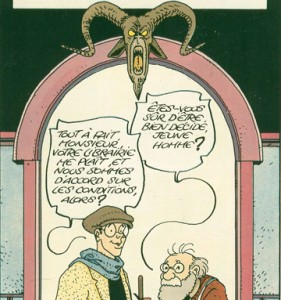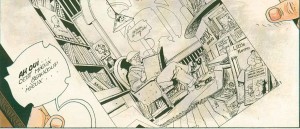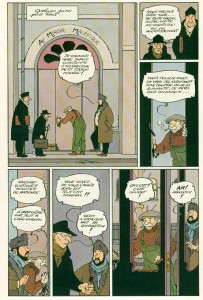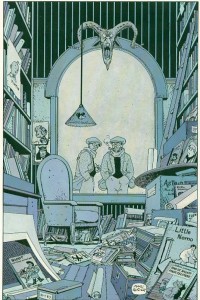One of the BD I picked up in Belgium was Le Reflet (the Reflection) by Marc-Renier and Yvan Hasse. One of the things I was specifically looking for as I browsed the European comic markets was metafictional works. I picked it up because Le Reflet is one such work – obviously so.
My French is not very good. It got marginally better over the summer, when I took my first French class in 22 years. However, I took the class after I read Le Reflet – which involved a painful, word-by-word flip through the French/English dictionary. There were several passages that didn’t make a whole lot of sense to me at the time, but I’m fairly sure that I got the gist of the whole story, if not the specifics.
Having said that, the whole piece has sat heavy on my mind for the past several months and I decided to take the opportunity that has been granted (the wife is on a girl’s weekend in Brooklyn) to unravel my thoughts on the work.
The book itself is very short. It’s not as wide as a standard BD album and it’s a brisk 30 pages long. The art is a Herge-influenced ligne clair style with a color scheme that is slightly more pastel than you would expect for a story with such dark themes. This makes sense, as Marc-Renier got his start working for Tintin magazine at about the same time. The two best things about the art are the numerous callouts to classic European BD (the story is set in a BD shop) and the tails on the word balloons, which have a beautifully art deco flip to them. The book was published in 1983, but the clothing on the characters suggests an earlier era – 1950s or 60s, maybe.

The plot is fairly straightforward: Marc owns a shop that specializes in classic BD, which he declares to be genius (“Genial,” above). He’s found an artist to illustrate a BD that he wrote – something of his own that he can place next to the canon on the shelf. The comic shop is named “Au Miroir Malefique” which translates into “In the Evil Mirror.” The reason for the name is an ominous mirror (that you can see below) that came with the shop when he first rented it. He took it as an omen. No, really. Accordingly, the BD is called Le Reflet (the Reflection) – an obvious nod to the name of the shop, which is appropriate because it’s about the history of the shop.

All of that gets established in the first dozen pages. In the next two pages, the book arrives. Unsurprisingly for those that have been paying attention, it is the book that the reader is currently reading. The title is the same, the cover is the same. In a broad hint about this eventuality, Marc is seen on page two holding an inked page for his yet-to-be published BD that is the same as the previous page.

Ann Miller’s Reading Bande Dessinee calls this Mise en abyme, where “art is transposed ‘to the level of the characters.'” Her book gives a more obvious example from Mathieu’s L’Origine, whose main character begins receiving pages of BD art in the mail – each one depicting a scene that has already occurred. Mathieu takes the conceit to an existential conclusion (to great effect), but it was published in 1991, seven years after Le Reflet was published.
It’s details like these that made me pick up Le Reflet in the first place. They don’t happen enough in Anglo-Saxon comics, but they seem to appear in the BD created in the land of French language theorists with startling regularity. What I found most interesting about this particular narrative artifact was what the creators did with it.
The final two-thirds of the book start with Marc receiving his books from the printer and then goes rapidly downhill as he finds himself completely unable to sell any copies of his books. The situation spirals out of control – he yells at customers and friends and grows despondent as boxes of books are returned and begin to accumulate.
Eventually, he shuts up the shop and hides with his BD. Unshaven and distraught, he talks to himself (literally – a clean-cut reflection that appears in the evil mirror and is his sole voice of encouragement) and eventually dies. His publisher friend finds his dead body and is astonished to flip to the back of Le Reflet to find a page that looks exactly like that scene; even moreso because it was not there the first time he read the book.

There’s a bit of a Twilight Zone ending to the story, but it’s a necessary twist. Without it, the whole construct begs to be given the third degree. To wit: did Marc knowingly write a story about his own downfall and death but pretended to be surprised when it came true? The implication comes with the conceit – the album published in the story is intended to be read as the actual album and vice versa. What happens in one will happen in the other. Fate happens to everyone eventually.
But if the content of the story changed after the fact, then Marc is not a self-destructive creator, merely a run-of-the-mill self-delusional one. And that’s a much easier position to understand; who hasn’t gone to those histrionic extremes in this day and age of self-publication? In fact, there’s every reason to believe that the original story Marc published was all about how wonderful he was and how successful this book was going to make him.
There’s more than a basic parable about believing your own hype here – I still haven’t unpacked the symbolism of the mirror. Obviously, calling the shop “In the Evil Mirror” is a broad hint at the nature of the mirror itself. But it also points at the nature of the relationship between the shop (and the universe it sits within) and the mirror; the shop is in the mirror, and is the evil reflection of some other, idealized world.
I doubt very much that Marc really thought too much about these implications. After all, “In the Evil Mirror” is a pretty awesome name for a local comic shop; it’s almost on par with “Forbidden Planet” without having to contend with all of the pop cultural baggage.
But one hopes that he thought about this stuff when he named his book Le Reflet; placed in the context, the BD becomes the reflection that is in the evil mirror. I don’t think he parsed the relational themes as presented. If he had, he might have figured out that the outcome he was experiencing was a result of being on the wrong side of the mirror.

The book ends with both reflections of Marc on the inside of the mirror, looking out at the mess that was created. In the end, it’s where Marc was probably meant to be.
One ironic footnote to the album. I found my copy in the bargain section of a used-BD store in Belgium. The price tag shows 2.50 euros and it’s obviously seen better days. Exactly where you’d expect to find a book that presents itself as a sales failure. I honestly wonder what happened to les Editions du Miroir (no kidding!) – as far as I can tell, they only put out a handful of books; two of which were written by Yvan Hasse. His entire bibliography.